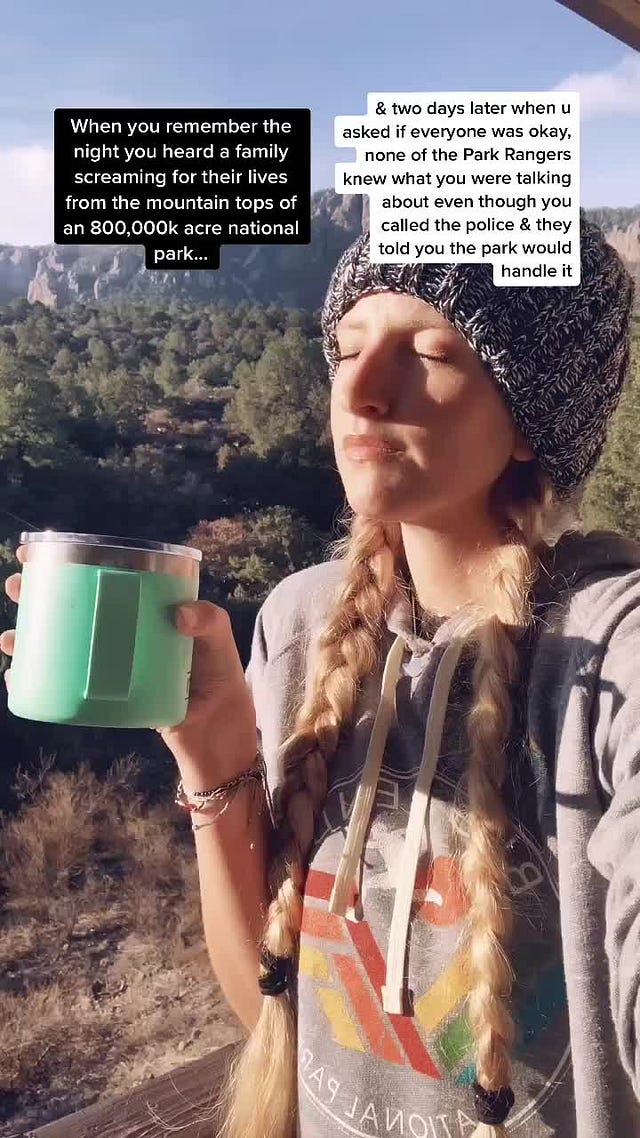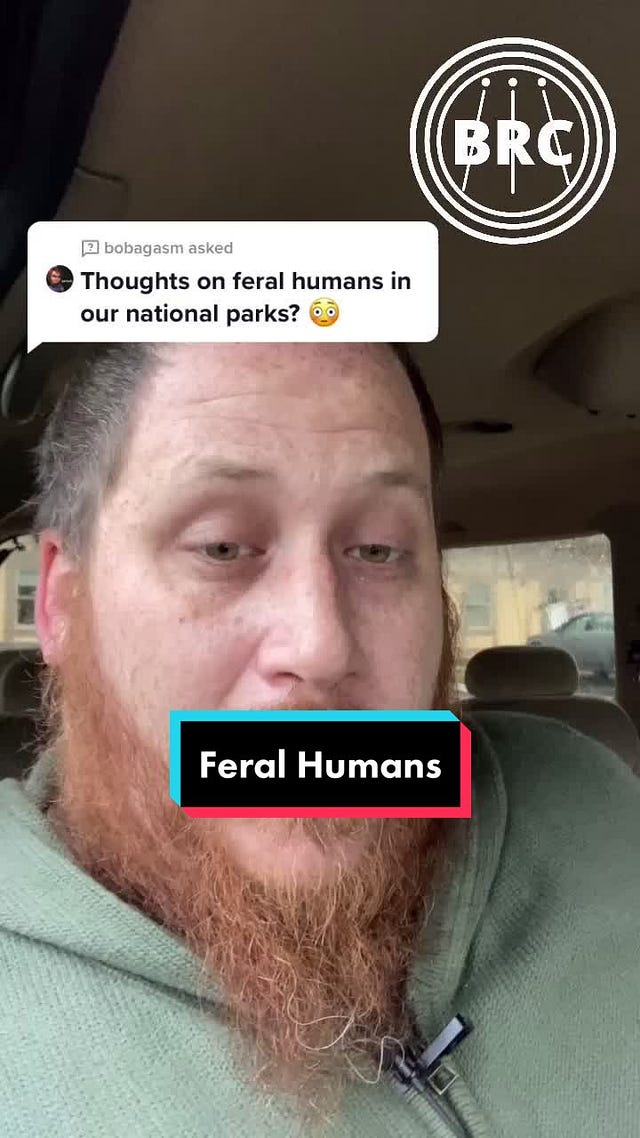Hello dear readers and welcome to a special edition of The Legend Queens!
Charlie Bartlett is one of our contributors and they are going to take you on a wild journey that has something to do with our present theme for the next season, Appalachia! We are so thankful for Charlie for this wonderful piece and hope to include future works form them in the future editions of The Legend Queens.
Help us out with a like, share, and even consider supporting us with a paid subscription.
Shall we begin?
It was in early 2021 that I stumbled upon the video that sent me down the (digital) path into the woods. Looking back, that year and the one before feels like a dreamlike fog — endless amounts of time spent on the couch with my then-roommates, scrolling our respective TikTok fyps and Instagram feeds, and falling down the wildest of rabbit holes.
Conspiracy theories and disinformation on social media were peaking at this time. We were all locked away at home, besieged by a relentless and terrifying virus, receiving confusing and contradictory information from our government, and voting in a monumental election. So while the topic at hand has nothing to do with health misinformation, it doesn’t surprise me that it gained traction while government suspicion was at an all-time high. Here’s the video I’m referencing:
Shortly after this was posted, other users began stitching the video to claim that what this woman most likely heard was an attack by “feral people” who live in American national parks — completely hidden and isolated from society — and practice cannibalism.
Many even claimed that not only are the feral people real, but that the government is very much aware of their existence and using the national park system as a means to cover it up.
Now, I LOVE a good national park horror story. Give me all the cryptids and stories of strange phenomena, please. If you’re also a fan, I’d highly recommend the podcast National Park After Dark, as well as the book Death in Yellowstone by Lee H. Whittlesey (for my more morbid queens). And when I first saw this video slide across my feed, I immediately thought of some horror classics: The Hills Have Eyes (1977), Wrong Turn (2003), and one of my all-time favorites, The Descent (2005).
But, of course, these movies are fictional. So, is there evidence to support these theories? The case I’ve heard most often cited by proponents of the feral people theory was that of Dennis Martin, a six-year-old boy who tragically went missing while on vacation with his family and friends in the Great Smoky Mountains National Park in 1969. In a plan to prank the adults, Dennis and three other children hid behind trees near a clearing where the group was resting. When the three others popped out to surprise their parents, Dennis was nowhere to be seen. After an extensive and record-breaking search for Dennis, there was no trace or remains found, making an accident or animal attack unlikely (though not impossible). Witnesses allegedly reported seeing a disheveled-looking man (possibly even wearing animal skins, according to a witness) near to where Dennis went missing, thus leading to speculation over the years that he was snatched by a mountain-dwelling cannibal.
John Gullion, a Tennessean journalist who writes about life in Appalachia and near the Smokies, is unconvinced of this theory. While he agrees the circumstances of Dennis’ disappearance are strange, mysterious, and tragic, he also understands how vast and dangerous the forest can be, no cannibals required. Between bears and other predatory animals, to natural hazards such as water and cliffs, to the simple fact that national parks are made up of miles and miles of wilderness, one wrong turn without knowing where you’re going, especially for a child, can mean the end. According to Gullion, “the most likely, easy explanation is he went in the wrong direction and panicked. He likely passed alone cold and terrified in the woods. The second likeliest is that an animal got him. Maybe it’s a combination of the two.”
Gullion concedes, however, that we really don’t know what happened to Dennis — and perhaps never will.
Despite efforts to debunk it, the feral people theory persists. And it’s easy to see why. Much like people speculate what could be lurking in the depths of the ocean, or in the farthest reaches of outer space, it’s fun to imagine spooky things in huge areas that are off-limits or hostile to the average person. Additionally, there were a reported 2,727 deaths in national parks in the twelve-year period from 2007-2018. And, like Dennis, people regularly go missing in the parks.
An author, ex-detective, and Bigfoot researcher named David Paulides chronicles these disappearances in a series of books and other media called Missing 411. Paulides focuses specifically on cases like that of Dennis Martin’s, wherein individuals go missing under “strange” circumstances, those that defy logical explanation. The Missing 411 data indicates a high number of such cases in American national parks, as well as negligence on the part of the Parks department to consistently track disappearances in the parks, naturally leading to suspicions of a government coverup of sorts. Proponents of the feral people theory often point to Paulides’ research as evidence that something weird is going on, and the presence of intelligent abductors who know how to cover their tracks proves a tempting explanation for how so many people are able to disappear without a trace. Critics of Paulides, including data scientists who have analyzed his findings, claim that while the data is accurately reported, it isn’t actually statistically significant. Still, we can only speculate as to what — or who — happened to all of these missing park visitors over the years.
I mentioned John Gullion earlier, but I had to wonder, what do other people who live in these regions think of these theories? In response to the virality of the original videos, TikTok creators who live near or spend a great deal of time in the national parks (particularly the Smoky Mountains region), posted their own videos (though, of course, nothing gains traction online quite as well as a conspiracy theory). These creators had their own theory about where these myths originated: classism. Rural Appalachian communities have historically been impoverished, lacking resources and forcing people to adapt and live off the land. This has resulted in the development of a rich and resilient culture, with close ties to the natural world and reverence for its mysteries. It’s also resulted in intense stigma — words like “hillbilly,” still common today, originated as derogatory terms for people living in the mountainous region. It’s easy to see how fear of these poor rural communities could spread among wealthy urban populations, morphing into a monster mythology of sorts. Creators also pointed out the history of moonshining — illegal alcohol production — in the Appalachian region, which could have incentivized communities to spread these myths themselves in order to keep outsiders away.
On that note — one thing I will say about this rabbit hole: it opened up my interest in Appalachian folklore and finding actual Appalachian creators who discuss the mythology and share spooky stories of their own. My two personal favorite creators are Morgan Lambert and Abbey Sobota, both of whom have cultivated large followings by sharing their unique experiences living and growing up in Appalachia. And don’t worry — they both have plenty of spooky, unexplained tales to last a lifetime of sleepless nights. Abbey, if you’re reading this, I promise to never whistle in the woods or look into the trees at night. Because even if the feral people myth is a red herring born from fear of our fellow humans, I believe there’s much more to the woods than first meets the eye.
Charlie is a writer, nonprofit fundraiser, and avid internet rabbit hole explorer living in the Twin Cities. She is especially interested in the overlap between disinformation/conspiracies, digital cults, politics, and spirituality. She occasionally muses about these things — as well as her love of toy collecting, horror movies, and journaling — on her TikTok and Twitter. Despite her critical approach to topics like these, Charlie practices her own eclectic spirituality and is a believer in the paranormal.
Her personal newsletter, Fish Brain, is in desperate need of a revamp, but that’s a 2024 goal.














